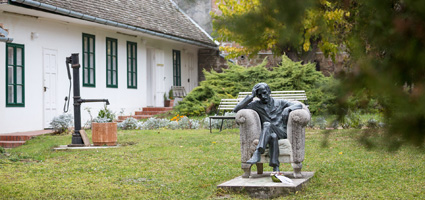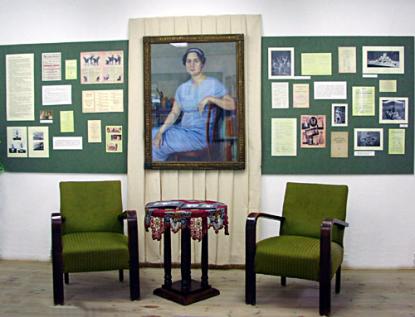2024. November 21. Thursday
Mihály Babits Memorial House - Szekszárd
 |
Address: 7100, Szekszárd Babits Mihály utca 13.
Phone number: (74) 312-154
E-mail: wmmm@terrasoft.hu
Opening hours: Temporarily closed.
|
Museum tickets, service costs:
|
Ticket for adults
|
500 HUF
|
|
|
Ticket for students
|
300 HUF
|
|
|
Ticket for pensioners
|
300 HUF
|
Valéria Dienes (born as Valéria Geiger) was born on 25, May, 1879. in Szekszárd. Her mother, Erzsébet Benczelits was a teacher; her father, Gyula Geiger was a liberal man, lawyer, and publisher. The Benczelits family were related to the family of Mihály Babits. As a child, Valéria often met the older Babits in the house along the creak Séd.

Valéria Geiger was among the first women to enroll in the Péter Pázmány University in 1901. She majored in mathematics and physics but at the same time, she attended the piano studies of the Music Academy. She met Pál Dienes there, who later was her husband. They took their doctorate together in 1905: Valéria Geiger in philosophy, mathematics, and aesthetics. After their marriage she used the name: Valéria Dienes.
In the school year of 1908/1909 Valéria Dienes studied in Paris at the Sorbonne. In 1908-12, she attended the lectures of the philosopher Henri Bergson, which influenced her greatly. The motion art - the modern dance of Isadora Duncan - also influenced her at first sight. She enrolled the Greek gymnastics courses of Raymond Duncan and after three months, she opened a motion art school. Its first performance was the first of the Hungarian modern dance art performances in 1917. Not only the material of the orchestic show of Valéria Dienes was modern but also was the text and the melody was harmonic with the movements. She designed her choreography for the poems of Ady and Babits, but in 1917, her students danced for the music of Bartók. Her friendship with Babits grew stronger in these years.
In 1928, she founded the Motion Culture Association. Its first motion drama titled 'Waiting for Dawn' was staged in 1925. The plays 'Eight Happiness' in 1926 and the 'Saint Imre Mystery' followed it in 1930. Besides the fairy plays for children she staged motion dramas for hundreds of characters among which the `The Journey of a Child (1935), or the "Patrona Hungariae" (1938) can be mentioned.
In the 20`s she returned to the religion of her childhood. First Henri Bergson, the man who broke the positivist-materialist point of view at the beginning of the century, influenced her. Her spiritual and intellectual relationship with Ottokár Prohászka, priest of Fehérvár, led her to Catholicism. Valéria Dienes was a polyhistor said the following of herself: 'Four rapsodies grew out of me through the years. I had four loves: music, mathematics, philosophy, and orchestics. All four helped me in my search in the world.'
The philosopher for ever in search of something new said good by to her loves at age 99 on 8, June, 1978.

Valéria Geiger was among the first women to enroll in the Péter Pázmány University in 1901. She majored in mathematics and physics but at the same time, she attended the piano studies of the Music Academy. She met Pál Dienes there, who later was her husband. They took their doctorate together in 1905: Valéria Geiger in philosophy, mathematics, and aesthetics. After their marriage she used the name: Valéria Dienes.
In the school year of 1908/1909 Valéria Dienes studied in Paris at the Sorbonne. In 1908-12, she attended the lectures of the philosopher Henri Bergson, which influenced her greatly. The motion art - the modern dance of Isadora Duncan - also influenced her at first sight. She enrolled the Greek gymnastics courses of Raymond Duncan and after three months, she opened a motion art school. Its first performance was the first of the Hungarian modern dance art performances in 1917. Not only the material of the orchestic show of Valéria Dienes was modern but also was the text and the melody was harmonic with the movements. She designed her choreography for the poems of Ady and Babits, but in 1917, her students danced for the music of Bartók. Her friendship with Babits grew stronger in these years.
In 1928, she founded the Motion Culture Association. Its first motion drama titled 'Waiting for Dawn' was staged in 1925. The plays 'Eight Happiness' in 1926 and the 'Saint Imre Mystery' followed it in 1930. Besides the fairy plays for children she staged motion dramas for hundreds of characters among which the `The Journey of a Child (1935), or the "Patrona Hungariae" (1938) can be mentioned.
In the 20`s she returned to the religion of her childhood. First Henri Bergson, the man who broke the positivist-materialist point of view at the beginning of the century, influenced her. Her spiritual and intellectual relationship with Ottokár Prohászka, priest of Fehérvár, led her to Catholicism. Valéria Dienes was a polyhistor said the following of herself: 'Four rapsodies grew out of me through the years. I had four loves: music, mathematics, philosophy, and orchestics. All four helped me in my search in the world.'
The philosopher for ever in search of something new said good by to her loves at age 99 on 8, June, 1978.
